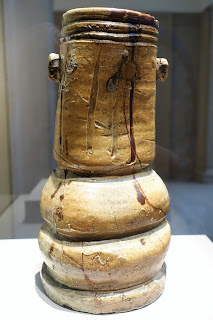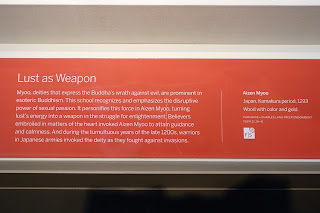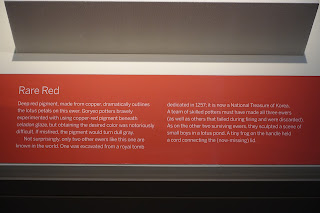A 15th-century depiction from central Tibet of Amitābha
Winter came early this year to the District of Columbia and its environs, but it didn't stay around long. This was the scene from our balcony as I awoke on Thursday morning:
Snow continued to fall throughout the morning and into the early afternoon:
What it looked like at work:
By mid-afternoon the snow had turned into rain and the ground began to get slushy. Come Friday morning the sun was out, and while the temperatures were low, they stayed above freezing, with much of the snow being gone by the time I woke up. If the day wasn't sunny enough already, I had the pleasure of an unexpected break from classes, as our instructors were busy doing "professional development", or something along those lines. My wife, as usual, elected to stay home, so I headed off by myself to see what was going on at my favorite pair of galleries in the District, the Freer Gallery of Art, and it's companion, the Arthur M. Sackler Gallery. Together they form the Smithsonian Institute's collection of Asian art, "where Asia meets America" (hence the title of this post). As always, I started with the Freer and its current Japanese exhibits. Painting the Classics: Japanese Screens features folding screens depicting scenes from The Tale of Genji 源氏物語, arguably the world's first novel. This Edo-period 江戸時代 pair dates from the 17th century:
It wasn't all folding screens and tea ceremony utensils. There were examples of hanging scrolls like this early 19th-century Edo-period depiction of the 11th-century warrior Minamoto no Yoshiie 源義家 returning to Kyōto 京都 after fighting in the north:
And in a precursor of things to come, there was this magnificent depiction of Amida 阿弥陀如来 from the early 14th-century, which came with a surprise from the 8th century inside! I'll let the caption tell the story:
The guardians of the Four Directions (from left to right: east, south, north and west):
Again, I'll let the captions explain this Kamakura-period 鎌倉時代 depiction of Aizen Myō-ō 愛染明王:
One of the Freer's ongoing exhibitions is the magnificent Peacock Room, which I've seen on my previous visits (see here and here):
Although the Freer is noted for its large Japanese collection, it also has extensive displays of Chinese arts and crafts...:
...as well as examples from the Korean peninsula:
A rarity indeed: this flower-shaped bowl stand from the Northern Song Dynasty 北宋 is an example of Ru ware 汝窯, the rarest of all Chinese ceramics:
A pair of bodhisattva. The one on the left is from northeastern Thailand and dates back to the 7th century (!); the one on the right is only eight or nine hundred years old and is either Cambodian or Thai in origin:
Video screens depict a day in the life of one the most important stupas in Sri Lanka:
The highlight of the exhibit is without a doubt the stunning Tibetan Buddhist Shrine Room, containing over two hundred objects of Tibetan Buddhist art from the Alice S. Kandell collection. The effect of the lighting and recorded chanting of monks creates an atmosphere that is absolutely mesmerizing. Unfortunately, I will probably never have the opportunity to visit Tibet due to the nature of my employment. Then again, even if I were able to go, I would be afraid to see what has happened to the culture as a result of Chinese government policies promoting Han migration into the region:
In the gift shop later, it took all my willpower to stop myself from shelling out $60 for a book detailing all the objects in the Tibetan Shrine Room (though I did buy some prayer beads that had been blessed by Tibetan nuns, with the money hopefully going to a good cause. I also purchased a book on Buddhist art at the Freer/Sackler). Desire is the cause of suffering, I had to remind myself. I also searched in vain for a CD of Tibetan throat singing similar to what was being played in the shrine room; here's a video shared from YouTube instead:
Another fascinating exhibition currently at the Sackler is Japan Modern: Photography from the Gloria Katz and Willard Huyck Collection, which features a selection of works from 20th-century Japanese photographers. My favorite was Town near U.S. Base, Gotemba, Shizuoka, taken in 1957 by Shigeichi Nagano 長野重一. It shows a group of children in postwar Japan playing near an American military facility that was located in the shadow of Mt. Fuji 富士山:
Resound: Ancient Bells of China showcases the development of bells in China, such as this bird-and-dragon motif example from circa 500-450 BCE (!). This exhibit also provides a rare hands-on opportunity, as visitors can sample the tones produced by replicas of the bells, using computer images to see the variations in sound wavelengths:
Returning to Nippon, Japan Modern: Prints in the Age of Photographs showcases how traditional woodblock printmakers tried to adapt in the age of photography, with some surprisingly artistic results. Shin-Ōhashi (1926), from the series Twenty Views of Tokyo by Hasui Kawase 川瀬巴水:
Another of Kawase's works - Dusk at Kiba (1920). I had to stand some distance away so as not to have my image reflected in the glare of the glass frame. Were I to be a performance artist, I would purposefully put my prints in highly reflective frames so that the viewer becomes part of the image, along the lines of John Cage and 4'33":
Autumn in Okutama (1927), by Un'ichi Hatsukawa 平塚運一, struck a chord as the area in question was one of my favorite weekend escapes from the urban expanse that is Tokyo (while still being a part of the Tokyo Metropolis 東京都):
The newest attraction on the National Mall is the National Museum of African American History and Culture, which opened in September 2016 while we were in Vilnius. Unfortunately, the required timed tickets for weekend visits are almost impossible to get, and we may have to wait until the next time we're in Washington to go, when some of the hoopla should have hopefully died down:
Passing by a couple of South American heroes on my way to the Metro station:
With my first Amharic evaluation to take place before Thanksgiving (and which I'll probably do horribly on), the visit to the Freer and Sackler galleries provided a brief though welcome break and an opportunity to experience something of Asia again, if only for a few hours on a weekday morning/afternoon. I'll finish this post with one nagging question, however, from these and other galleries/museums I've visited over the years in the West: was there nothing worthwhile in Taiwan to be
Perhaps that question is better left as a kōan 公案...













































No comments:
Post a Comment